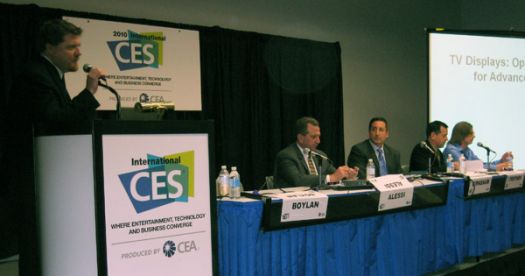CES is much more than an opportunity for members of the press to meet with manufacturers and check out the latest and greatest gadgets and gear close-up. It's also a Mecca for interested parties from all branches of the consumer electronics industry to come together to discuss topics and trends with informed individuals. To that end, Big Picture Big Sound Editor Chris Boylan roped in a who's-who from the video display manufacturing community for a CEA panel session aimed at answering the burning question, "TV Displays: How Long Will LCD Stay King?"
After an introduction by Boylan, LG's Tim Alessi kicked off the afternoon by taking a look back at LCD's evolution from 2000 to the present, and its continuing innovations, with the promise of more to come. With the advent of LED-backlit LCD, the battle of picture quality versus thickness might be solved, but will the next decade bring OLED? Ultra HD? Holography? Time will tell.
Scott Birnbaum of Samsung reminded us of the challenges that LCD once posed to manufacturers, but also the advantages it brings to consumers. His conclusion: yes, it can remain the king, but it must continue to evolve - LED lighting, 3D technology and ever thinner panels are helping to make LCD sets compelling to today's consumer. Gary Feather of Sharp also gave his take on the history of LCD, noting the ancillary benefits along the way, including the handheld calculator and the laptop computer. He agreed with other panelists that LCD can't rest on its laurels, but must be (and will be) improved in ways that matter to consumers so it can continue to be viable.

Ken Lowe of VIZIO was proud to be "the new guy," one of the original founders of the company from 2002. They were originally a high-value plasma company until the decision in 2008 to concentrate on LCD, responding to popular demand. With a small staff and low overhead, VIZIO has been able to offer extremely competitive price points that have resulted in huge market share, clear proof that aggressive pricing is also essential to LCD's future.
All of the guest speakers were curious--if cautious--about the importance of 3D, but agreed that content will ultimately make it or break it. At CES, all of the companies have either announced specific models or plans to release 3D-capable LCD TV models in the near future.
One of the most interesting and ironic audience questions pondered that, with 10% overall market share at the present time, what's next for plasma? Plasma continues to sell well within its niche of consumers - and competes well with LCD TVs in larger screen sizes where its competitive price and excellent contrast and other picture quality advantages help it to gain a large chunk of the market. The infrastructure is already in place to build them, and so its share of the market is expected to stay fairly consistent for the foreseeable future. The recent, stringent power consumption guidelines won't help hungrier plasma displays, so energy efficiency innovation must continue. Both LG and Samsung, who still have plasma models in their lines, said they plan to continue to support and enhance the technology for the foreseeable future.
The general consensus? Despite promising new technologies such as OLED waiting in the wings, LCD technology is getting better every year and it's likely to rule the roost with dominant share of in the HDTV market for at least the next 5 to 10 years.
And then, the crystal ball went dark.
More CES 2010 Coverage Live from Las Vegas: